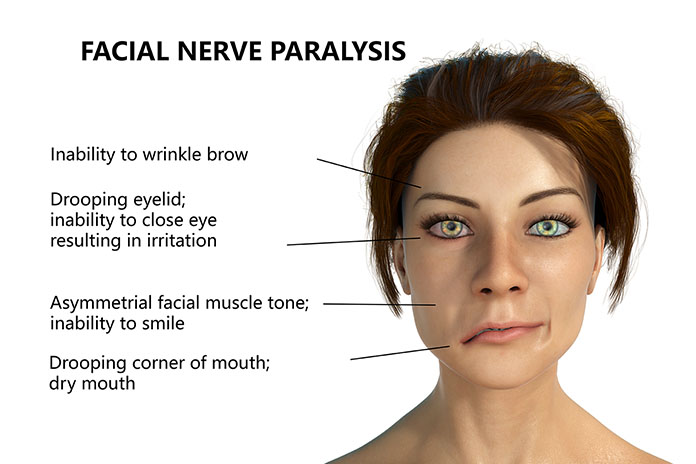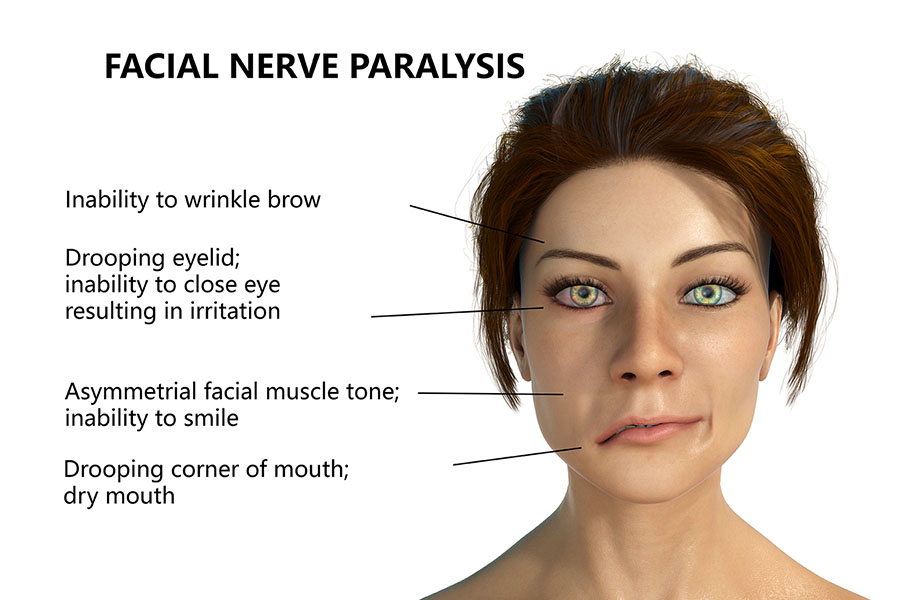What is Bell’s Palsy?
Bell’s palsy is a condition that has not only physical symptoms, but also an emotional impact. Physically, it’s a kind of facial paralysis that’s almost always one-sided. Bells’s palsy is caused by a problem with one of the 12 cranial nerves that connect your brain with parts of your head, face, neck and upper trunk. The paralysis associated with Bell’s palsy occurs at the 7th cranial nerve, called the facial nerve, which controls the muscles in your face, eye blinking and your ability to smile and make facial expressions. Your facial nerve also supplies neural impulses to your saliva and tear glands, your sense of taste and the small bones of your middle ear.
The emotional effects of Bell’s palsy can be disturbing for many people who suffer from it, because they perceive the one-sided paralysis of their face to be disfiguring. Many patients with this condition say that it can cause stress, anxiety, depression and the avoidance of social situations. Furthermore, it inhibits a person’s ability to smile and make the facial movements that are an important part of communication and social encounters.
The symptoms of Bell’s palsy typically have a fairly rapid onset, occurring within a period of two to three days. While most cases affect only one side of your face, in rare instances it can affect both. The symptoms vary from person to person and can range from mild facial weakness to complete paralysis of one side of your face. Most commonly, people with this condition report weakness of one side of their face. In addition to distortion of the affected side, symptoms include the inability to blink, eye dryness, excessive tearing, mouth droop and drooling. In some cases, sufferers may have facial pain, loss of or altered taste, hypersensitivity or unusual sensations in the face and hypersensitivity to loud noises.
Scientists aren’t clear on the exact cause of Bell’s palsy. What they do know is that inflammation and swelling of the 7th cranial nerve is prevalent in this condition. One theory as to what triggers the inflammation of this nerve is that a dormant virus that’s been hiding out in the cranial nerves may become activated. Stress, decreased immunity, autoimmune conditions, trauma or an illness like a cold or the flu may set off the cascade of inflammation and swelling of the nerve that triggers this condition.
When the facial nerve swells, it causes pressure where the nerve travels through a bony canal on its way to your face. The pressure restricts the circulation of blood, oxygen and nutrients to the nerve branches in your face, causing the weakness and paralysis associated with Bell’s palsy.
About 40,000 people in the United States get Bell’s palsy each year. While it can affect anyone, it’s most common in younger people between the ages of 15 and 45. Risk factors for this condition include pregnancy, high blood pressure during pregnancy (preeclampsia), being overweight, high blood pressure in general, diabetes and having had a recent upper respiration infection.
On the bright side, the symptoms of Bell’s palsy tend to start improving after a few weeks for most people, with most experiencing some return of facial function within about four to six months. For some sufferers however, facial weakness may take longer to resolve, and for others the loss of function may be permanent.
Treating Bell’s Palsy
Conventional treatments for Bell’s palsy include the use of oral steroids, especially if they’re started within the first 72 hours of symptom onset. In tandem with steroids, the use of antiviral medications may also help with recovery. Eye protection is also an important component in treating Bell’s palsy. Because blinking and closing your eye is impaired, keeping your eye moist with artificial tears, eye drops and moisturizing ointments may be necessary. In some cases, an eye patch to keep your eye closed may also be necessary.
Natural treatment in the form of acupuncture can also be helpful in treating this condition. Acupuncture has a long history in treating Bell’s palsy, and research backs this up. A number of studies have documented that acupuncture and Chinese medicine is a safe and effective way to treat the symptoms associated with this condition.
While acupuncture may seem like an unlikely treatment for facial paralysis, it actually works for a number of reasons. Research has found that it can effectively reduce inflammation and increase circulation, both factors associated with nerve impairment in Bell’s palsy. In addition, acupuncture can address stress, anxiety and depression associated with both the onset and the subsequent symptoms of this condition. If you choose to treat your Bell’s palsy with acupuncture, your practitioner will also determine any underlying imbalances that may be contributing to this condition. In many cases, being run down and depleted is a common pattern for people who develop Bell’s palsy. Your practitioner may also incorporate Chinese herbs into your plan to support your acupuncture treatment, nutritional strategies to build up your body constitution, as well as a kind of bodywork called Tui Na to help improve circulation to your face and speed up the healing process.
While Bell’s palsy can be a distressing condition to have, there’s good news in that it typically resolves within a few months. If you want to know about how acupuncture can speed up recovery from Bell’s palsy, contact our clinic for more information.

Cindy Chamberlain is an acupuncturist in Overland Park, KS and the founder of Eastern Healing Solutions, LLC. She is licensed in Kansas and Missouri and has been practicing traditional Chinese medicine since 1996.



